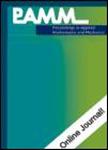版权所有:内蒙古大学图书馆 技术提供:维普资讯• 智图
内蒙古自治区呼和浩特市赛罕区大学西街235号 邮编: 010021
T=题名(书名、题名),A=作者(责任者),K=主题词,P=出版物名称,PU=出版社名称,O=机构(作者单位、学位授予单位、专利申请人),L=中图分类号,C=学科分类号,U=全部字段,Y=年(出版发行年、学位年度、标准发布年)
AND代表“并且”;OR代表“或者”;NOT代表“不包含”;(注意必须大写,运算符两边需空一格)
范例一:(K=图书馆学 OR K=情报学) AND A=范并思 AND Y=1982-2016
范例二:P=计算机应用与软件 AND (U=C++ OR U=Basic) NOT K=Visual AND Y=2011-2016



Wind energy plays a critical role in the transition towards renewable energy sources. However, the uncertainty and variability of wind can impede its full potential and the necessary growth of wind power capacity. To mitigate these challenges, wind power forecasting methods are employed for applications in power management, electricity trading, or maintenance scheduling. In this work, we present, evaluate, and compare four machine learning-based wind power forecasting models. Our models correct and improve 48-hour forecasts extracted from a numerical weather prediction (NWP) model. The models are evaluated on datasets from a wind park comprising 65 wind turbines. The best improvement in forecasting error and mean bias was achieved by a convolutional neural network, reducing the average NRMSE down to 22%, coupled with a significant reduction in mean bias, compared to a NRMSE of 35% from the strongly biased baseline model using uncorrected NWP forecasts. Our findings further indicate that changes to neural network architectures play a minor role in affecting the forecasting performance, and that future research should rather investigate changes in the model pipeline. Moreover, we introduce a continuous learning strategy, which is shown to achieve the highest forecasting performance improvements when new data is made available.


电话和邮箱必须正确填写,我们会与您联系确认。
版权所有:内蒙古大学图书馆 技术提供:维普资讯• 智图
内蒙古自治区呼和浩特市赛罕区大学西街235号 邮编: 010021

暂无评论